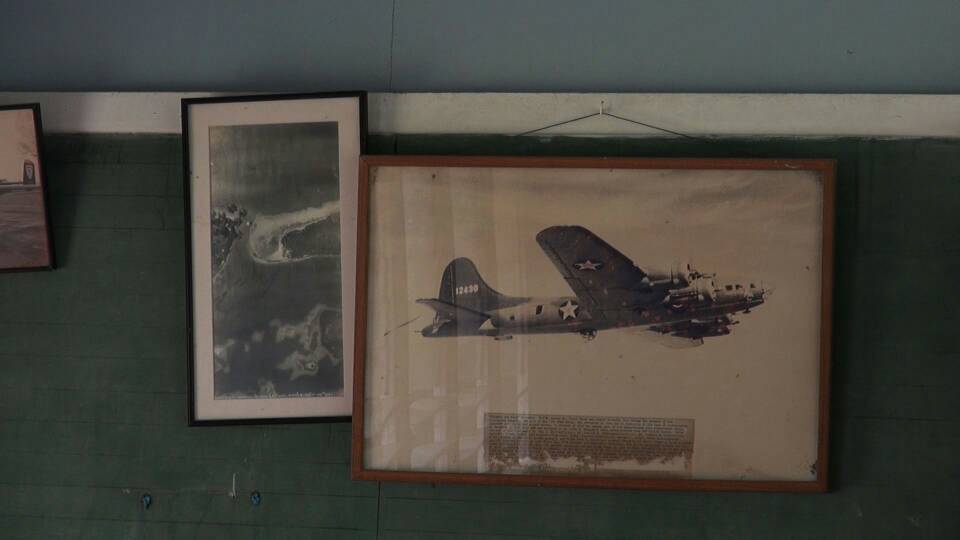In an exhibition room at the Kokopo War Museum lie the relics of a 40-year-old flying fortress dubbed “Naughty But Nice”.
What’s left of it, is a lower section of its cockpit and turret.
It has a nose art of a half naked woman.
The wreckage was discovered in 1982 with the nose art still visible.
‘Naughty But Nice’ is one of thousand pieces of war relics retrieved and stored for public exhibition at the Kokopo War Museum.
Next to its remains, is an old photo frame covered in dust and cobwebs – a picture of its crew members.
Pilot: 1st Lt. William J. Sarsfield, Jr., (MIA / KIA, BR) Philadelphia
Co-Pilot: 2nd Lt. Charles E. Trimingham, (MIA / KIA, BR) California
Bombardier: 1st Lt. Francis G. Peattie (MIA / KIA, BR) New York
Navigator: 1st Lt. Jose L. Holguin (POW, survived) Los Angeles, CA
Asst Bomber: 2nd Lt. Herman H. Knott, (MIA / KIA, BR) New York
Engineer: T/Sgt. Robert L. Christopherson, (MIA / KIA, BNR) Minnesota
Asst. Engineer: S/Sgt. Henry Garcia, (MIA / KIA, BR) Los Angeles
Radioman: T/Sgt. Leonard A. Gionet, (MIA / KIA / BR) Minnesota
Asst. Radioman: S/Sgt. Robert E. Griebel, (MIA / KIA, BR) Wyoming
Gunner: S/Sgt. Pace P. Payne, (MIA / KIA, BR) Texas
While the remains seem of little worth, it was the fortress of the sky, part of a convoy of 130 other planes during the battle of the Pacific.
Naughty But Nice was a B-17 bomber used by the US Air Force during the Second World War.
The plane fought in numerous air battles between US and followed the war until it reached the Pacific in 1942 where it was stationed at the ‘7-Mile Drome’ (Now Jacksons Airport)
Naughty But Nice, underwent maintenance work until it was called in to Port Moresby to provide air support for the battle of Bismarck Sea shortly after the Japanese invaded the Port of Rabaul on March 3rd, 1942.
On June 23rd, 1943, a year after the Japanese Invasion, Naughty But Nice was put to work for a night bombing mission at the Japanese airbase at Vunakanau, outside of Rabaul. After accomplishing its mission, the plane was returning to base when it came under intense fire by a Japanese gunner.
Historical data revealed that the Japanese anti-bomber plane was piloted by Shigetoshi Kudo, a reconnaissance pilot who engaged in three firing passes using its 20mm cannons.
The second pass killed pilot Sarsfield while the third attack set the plan on fire.
Holguin, who was the plane’s navigator bailed out of the plane before it crashed into the Baining Mountains, southeast of Rabaul.
The other nine crew members did not make it.
Holguin was the only survivor who lived to tell the story of their fatal crash
In a testimony revealed by Holguin in an air crash report, Holguin stated: “ Our aircraft received a direct hit on No. 1 engine, causing it to burn. No. 2 engine was not functioning properly… In this attack I was wounded in the jaw by .30 cal shells which momentarily rendered me dizzy.”
Holguin received severe wounds to his jaws and back but managed to crawled through the dense Baining mountains for several weeks before he was rescued by natives.
The locals, however, handed him to the Japanese as they couldn’t assist him recover from the sever injuries.
Holguin was captured as a Prisoner of War until the end of the war.
The search for the other 9-crew members continued for several years.
In September 2011, after 29 years from the initial search, the remains of the 9 missing crews were identified and exhumed in the Baining Mountains.
The bodies of all nine men were repatriated to the United States and buried in a single casket at the Airlington National Cemetery in Hawaii.
Today, the pieces of ‘Naughty But Nice’ lie at the Kokopo War Museum.
But its history, lies unbroken and largely untold.


